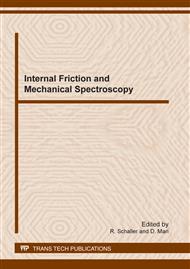p.283
p.289
p.295
p.301
p.307
p.313
p.319
p.325
p.333
Amplitude Dependent Damping of Aluminum-Matrix-Nanoparticle-Composites
Abstract:
Aluminum-matrix-nanoparticle-composites were produced by ball milling of micro scale aluminum powder in air atmosphere with subsequent consolidation by hot extrusion and also additional hot swaging. They were investigated in this condition after step by step isochronal annealing with successive increasing annealing temperature and quenching into water to room temperature. The material was investigated by amplitude dependent damping, hardness and density measurements, all at room temperature. For all measured amplitude dependent internal friction (ADIF) curves the damping increases with increasing strain amplitude. After some annealing treatments a knee occurs in the medium strain amplitude region of these curves. Moreover between annealing temperatures from 360°C to 480°C the strain dependent damping becomes a maximum, i.e. a peak in the ADIF curves occurs. Other ADIF curves of quenched and fatigued material show characteristic peaks that can be attributed to individual single cracks. It is shown that all these effects are due to the formation, opening and compression of cracks present in the sample or created by thermally exerted stresses.
Info:
Periodical:
Pages:
307-312
Citation:
Online since:
January 2012
Authors:
Price:
Сopyright:
© 2012 Trans Tech Publications Ltd. All Rights Reserved
Share:
Citation:


